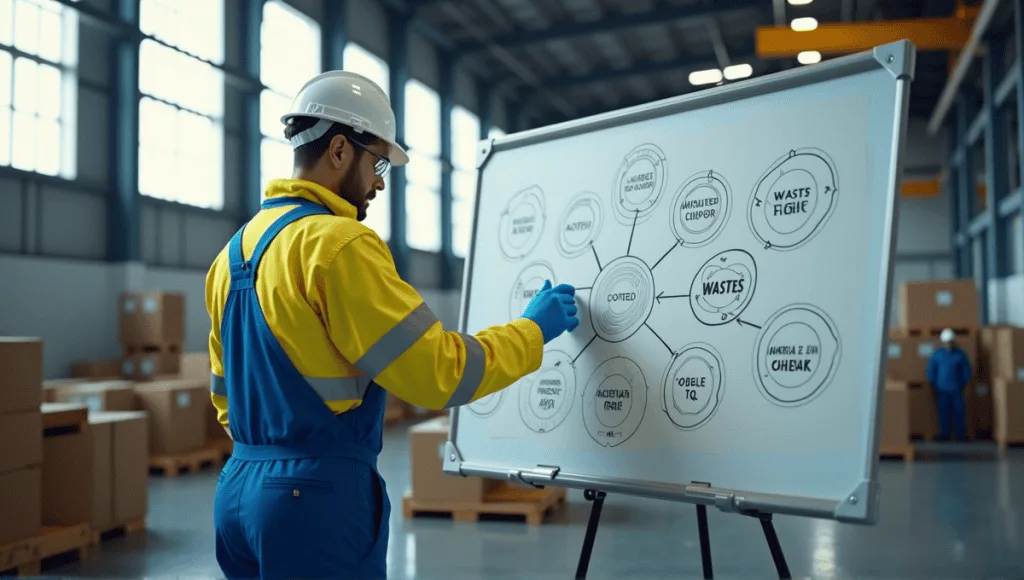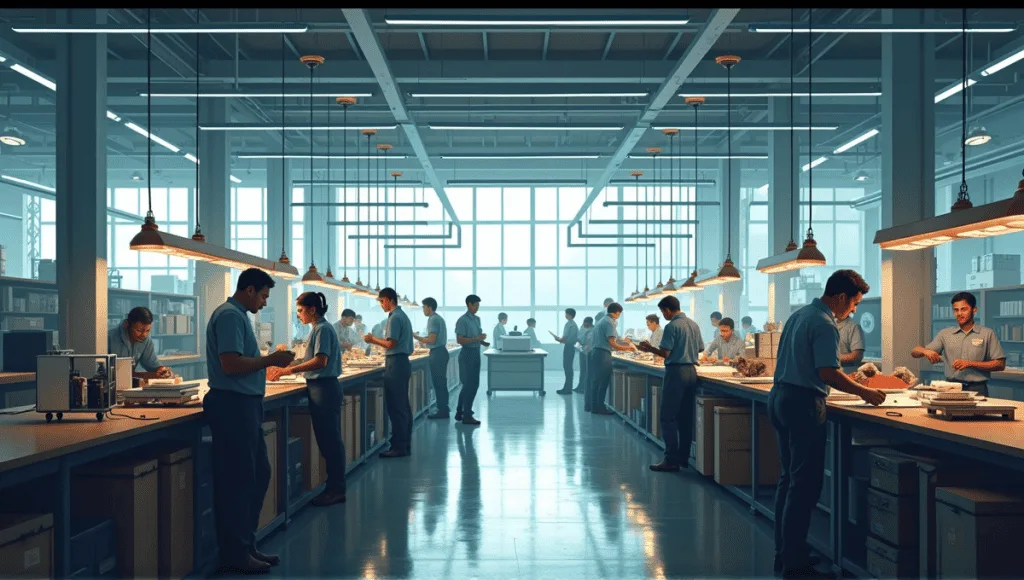As a lean management consultant, I’ve witnessed the 8 wastes devastate companies. These are hidden inefficiencies that quietly consume resources and prevent the business from scaling. Knowing how each waste affects your operation is essential to remain competitive. Below, I’ll outline each waste and how you can reduce it. This will enable you to optimize processes and increase your bottom line.
Understanding the 8 Wastes in Lean Manufacturing

The 8 Wastes concept is one of the core principles of Lean Manufacturing, and it allows businesses to identify and eliminate non-value added activities within their processes. I’ve seen this concept revolutionize companies in various industries.
The 8 Wastes originated from the Toyota Production System and are often remembered by the acronym DOWNTIME, which stands for Defects, Overproduction, Waiting, Non-utilized talent, Transportation, Inventory, Motion, and Excess processing.
Identifying and eliminating these wastes is essential to improving business processes. It’s not just about cost savings. Instead, you’re improving productivity, efficiency, and customer satisfaction.
Here’s how the 8 Wastes affect your business:
- Lower profitability
- Decreased customer satisfaction
- Lower employee morale
- Increased lead times
- Inefficient use of resources
Research indicates that up to 95% of process time is non-value added waste, and only 5% actually adds value for the customer. This statistic blew my mind when I first heard it. It illustrates the significant opportunity for improvement in most businesses.
Historical Context of the 8 Wastes
The 8 Wastes concept originated from the Toyota Production System, which transformed the manufacturing industry and laid the groundwork for Lean principles.
Taiichi Ohno, a key influencer at Toyota, identified the original seven wastes. He noticed these inefficiencies on the manufacturing plant floor and developed strategies to eliminate them.
Over time, the concept changed slightly. As Lean principles expanded beyond manufacturing, the eighth waste was added: non-utilized talent. This change reflected the idea that human potential is a critical asset in organizational success.
The evolution of the 8 Wastes is a microcosm of a larger shift in business thought. It’s no longer just about efficient production. Today, it’s about maximizing value across an entire organization.
Waste #1: Defects in the Lean Manufacturing Framework
Defects are products or services that fail to meet specifications. They’re a major waste of resources. In manufacturing, defects might be parts that don’t work. In service businesses, they might be mistakes in customer orders.
The impact of defects on a business is significant. They eat up 15-30% of total production costs. This number always surprises my clients. It’s not just the cost of the item that’s defective. You’re also losing time, materials, and potentially customers.
Common causes of defects include:
- Poor process design
- Insufficient employee training
- Poor quality materials
- Equipment failure
To eliminate defects:
- Use strong quality control vs quality assurance processes
- Invest in employee training
- Regularly maintain equipment
- Create a culture of continuous improvement
Remember, defects aren’t just a manufacturing problem. They can occur in any process in any business.
Waste #2: Overproduction in the 8 Wastes Model

Overproduction is producing more than necessary or before it’s necessary. It’s often referred to as the “mother of all waste” because it creates other forms of waste.
I’ve seen overproduction in every industry – restaurants that make too much food and throw it away, software companies building features that users don’t use, manufacturers producing excess inventory that sits in a warehouse.
The root causes of overproduction are:
- Poor demand forecasting.
- Inefficient production scheduling (running equipment as much as possible).
- “Just in case” thinking.
- Misaligned incentives.
To reduce overproduction:
- Use pull systems.
- Build better demand forecasts.
- Produce based on what customers are asking for.
- Scrutinize production schedules.
Overproduction can be tricky to identify. It isn’t always as obvious as a pile of inventory collecting dust. Look for any process that’s producing more than you need or earlier than you need it.
Waste #3: Waiting in the 8 Wastes System
Waiting waste occurs when people, materials, or information is waiting. It is time that does not add value to your product or service.
The average employee spends 28% of their time waiting. That’s almost one-third of the workday! This is often a shocking statistic for my clients. It’s also a massive opportunity for improvement.
Common examples of waiting waste include:
- Equipment waiting (breakdowns, changeovers, etc.)
- Process waiting (bottlenecks, overprocessing, etc.)
- Schedule waiting (people waiting, delayed information, etc.)
- Information waiting (inefficient data, no real-time data, etc.)
Waiting waste impacts people’s productivity, but it also negatively impacts how engaged they feel. Nobody wants to feel like they aren’t getting anything accomplished.
To eliminate waiting waste:
- Balance the workload
- Use preventative maintenance
- Implement better communication
- Use visual management
Waste #4: Non-Utilized Talent in Lean Manufacturing
Underutilized talent is failing to maximize the skills, talents, and creativity of your employees. It’s a silent killer that undermines the potential of your workforce.
Consider this: Only 30% of employees are actively engaged at work. This results in $450-550 billion in lost productivity annually in the US. These statistics always surprise my clients.
Factors contributing to underutilized talent include:
- Strict job roles
- Inefficient task assignments
- Limited development opportunities
- Ineffective communication
To maximize employee talent:
- Cross train employees
- Use a suggestion system
- Offer development programs
- Create an environment of innovation
Your employees are your greatest asset. Failing to maximize their skills and creativity is a missed opportunity to innovate and grow.
Waste #5: Transportation in the 8 Wastes Model

Transportation waste is any unnecessary movement of materials, information, or people, which does not add value to the product or service.
In manufacturing, transportation can account for as much as 25% of labor costs. That’s a lot of labor cost devoted to activities that don’t add value!
Common culprits of transportation waste include:
- Poor facility layout
- Inefficient supply chain design
- Unnecessary material handling
- Ineffective information flow
Here’s a table listing various ways to eliminate transportation waste:
| Approach | Description |
|---|---|
| Value Stream Mapping | Visualize and analyze material and information flow |
| Cellular Layout | Group sequential activities to minimize transportation |
| Point-of-Use Storage | Store materials as close together as possible |
| Digital Communication | Eliminate physical transportation of information |
Keep in mind transportation isn’t just referring to physical movement. It can also apply to the unnecessary movement of information or data.
Waste #6: Inventory in Lean Manufacturing Principles
Inventory waste is any excess material, WIP, or finished goods that you have. It ties up capital and can also mask other inefficiencies in your process.
Inventory waste carries through to inventory carrying costs, which are typically 20-30% of the inventory value annually. This is a number most clients don’t realize until we calculate it. It’s not just the cost of the actual , though. You’re also paying for storage, handling, and the potential obsolescence of that categoroy of inventory.
Common causes of inventory waste include:
- Overproduction
- Poor demand forecasts
- Long setup times
- Unreliable suppliers
To manage and reduce inventory waste:
- Use Just-in-Time production
- Improve demand forecast accuracy
- Reduce setup times
- Work with reliable suppliers
Remember though that inventory can be anything that your company can’t process. In a service business, it might be a backlog of work or unprocessed information.
Waste #7: Motion in the 8 Wastes Framework
Motion waste is any unnecessary movement of people or machines within a process. This is different from transportation waste, which refers to the movement of materials or information.
Motion waste can reduce productivity by 20 to 30%, although this often goes unrecognized. The impact is more than just the time wasted. Excessive movement also causes fatigue and safety issues, and it creates long-term health problems.
Common sources of motion waste include:
- Poor workstation layout
- Inadequate tools or equipment
- Inefficient work methods
- Lack of standard operating procedures
To reduce motion waste:
- Optimize workstation layouts.
- Ensure the right tools and equipment are provided.
- Standardize work methods.
- Establish standardized operating procedures.
- Engage employees to help improve.
Keep in mind that motion waste isn’t always easy to see. Watch for unnecessary reaching, bending, or walking in your processes.
Excess Processing: A Key Inefficiency in Lean Manufacturing
Excess processing is when you do more work than is required to deliver the product or service. It involves incorporating more features or steps that do not add value from the customer’s perspective.
Overprocessing waste is another 10-30% of administrative work steps. Many of my clients are surprised by this statistic because overprocessing is often rampant in office settings.
Factors that cause overprocessing include:
- Unclear customer requirements
- Outdated procedures
- Redundant approvals
- Gold-plating” (i.e., over-complicating)
To eliminate extra processing steps:
- Clarify the customer requirements.
- Periodically revisit and update procedures.
- Remove redundant approvals.
- Focus on value-added tasks.
Keep in mind what you believe is necessary may not be adding value for the customer. Always analyze your processes from the customer’s perspective.
One effective tool for analyzing and improving processes is A3 problem solving. This structured approach can help you identify and address issues like excess processing more effectively.
A Few Last Words
The 8 Wastes framework is an excellent resource for optimizing business processes. I’ve witnessed it work wonders for virtually any business. By addressing defects, overproduction, waiting, underutilized talent, transportation, inventory, motion, and over processing, you can make processes significantly more efficient.
Don’t forget that small wins create big results. Begin by identifying the main waste areas in your business and then apply specific solutions. You’ll be pleasantly surprised at the results. Continuous improvement is a core principle of business. As long as you continue optimizing processes, you’ll always stay ahead.






